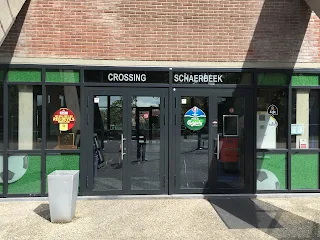Crossing Schaerbeek is a Belgian football club from the Schaerbeek district of Brussels, who were originally formed as Union Sportive Albert Schaerbeek in 1945. As with many other Belgian clubs, their history is complicated.
RUS Albert Schaerbeek (RUSAS) played in the Chazal stadium in Schaerbeek and had green and white as colours while competing in the lower levels of Brabant provincial football. However, progress was made in the new millennium. RUSAS climbed to the top level Brabant 1ère Provinciale before entering into a merger with RFC Evere.
RFC Evere
RFC Evere was a Belgian football club from Evere, the district to the east of Schaerbeek. The club played all its existence as a provincial club and was originally formed for officers of the Belgian Air Force as SC Evere.
The club earned the nickname ‘Les Aviateurs’, soon becoming attractive to the youth of the area, leading to non-military players joining the club in 1934. Until the Second World War, the club continued to play at the military airport. In 1945, the club merged with another team, Evere HO, thus forming SC Evere HO.
In 1974-75, the side finished third in Division 3 A, which was replicated in 1978-79. The team was relegated to Promotion B the following season. In 1989, the team merged with Young Fellows Evere, and in 1994, Red Star Evere also joined up. In 2011, the club became champions and won promotion from the second level of provincial football.
Crossing Schaerbeek
2012 saw a complicated twist, as Evere merged and took the license of another local club, RUS Albert Schaerbeek (RUSAS), to become Crossing Schaerbeek Evere. Meanwhile, RRC d'Etterbeek bought the license number of Evere to play in the top level of the provincial league.
Crossing started in 2012 in the Brabant First Provincial league, where it immediately merged with another recently promoted Schaerbeek club, RC de Schaerbeek. In 2013, the club name was shortened to Crossing Schaerbeek as the team progressed to a third-place finish in Brabant 1ère Provinciale in 2014-15, which was followed up by a couple of mid-table placings.
The new club name was a reference to Royal Crossing Club de Schaerbeek, a former top-level provincial club that moved to Elewijt after mergers of its own in the 1980s. Crossing Schaerbeek Evere moved to the rebuilt Crossingstadion in the Josaphat Park in Schaerbeek.
Crossing ended the 2017-18 campaign in sixth place, which was replicated the following season. The team was clear at the top when the 2019-20 season was cut short owing to the COVID-19 pandemic, with promotion issues still in the air.
Promotion to Belgian Division 3 ACFF arrived, and saw Crossing finish in third place under manager Samuel Petit. Crowd trouble in the playoff against Binche saw the visitors awarded the tie while it was balanced at 4-4 in the penalty shoot-out as Crossing were deemed not to have taken sufficient safety precautions and not arranged proper segregation.
Fourth place followed, before the appointment of new manager, Dave De Herdt. The team reached the playoffs in 2023-24, defeating Elsautoise, Manageoise, and then Raeren-Eynatten to win promotion to the fourth-tier Belgian Division 2. The title was won at their first attempt, taking Crossing to the Belgian Division 1, with Esteban Casagolda top scoring.
Crossing Schaerbeek will play in the Belgian Division 1 in the 2025-26 season.
My visit
Saturday 19th August 2017
I’d just arrived in Brussels from my visit to Liége for the Standard home game the previous evening. I’d prepared a list of venues that I wanted to visit over the long weekend and had considered heading straight to my hotel to check in. However, I had a Plan B.
As I was already at Centraal Station, I thought it a bit of a waste not to set off and buy my 48-hour travel pass on a MOBIB card from the Metro station kiosk. I dropped my rucksack off in the left luggage lockers and set out on my adventures.
Fortunately for me, the buses departed from outside the Metro station. I soon located my stop and awaited the number 66 bus northeast, past my hotel, giving me a handy look at its location and through the streets to Crossing.
I alighted on the corner of Avenue Louis Bertrand and Avenue Voltaire, where there was a police presence ahead of an event in the adjacent Parc Josaphat. Going over the railway bridge, I was soon outside the large venue with its imposing end stand.
Both Crossing and Racing had separate offices and clubhouses in the rear of the stand, which looked like its upper tier had gone since the big match days. The gates weren’t open to head inside, but I wasn’t to be beaten.
A walk down the park side took me to a gate which offered an excellent view of an impressive stadium. The far end had terracing in front of the offices, while the far side had a raised seating deck running the full length of the pitch.
The artificial pitch continued behind the near goal to provide a practice area, while the open side had a few steps of open terracing, where I presume a stand once stood in the 70’s? The local authorities had done a magnificent job of keeping the venue alive and fit for modern football.












No comments:
Post a Comment